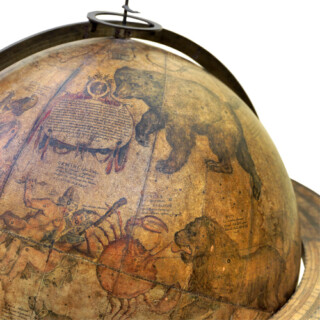The only French game played with Spanish suits
Jeu de l'Aluette [or] Cartes des Pêcheurs
[ANONYMOUS]
Paris,
B.P. Grimaud,
[c1880-90].
48 woodblock printed playing cards with fine original hand-colour, black pattern to versos.
87 by 57mm (3.5 by 2.25 inches).
20730
To scale:
notes:
notes:
The Maker
The Ace of Coins shows an illustration of a castle within a circular cartouche surmounted by an eagle; beneath this is a banner reading the publisher's name: "B. P. Grimaud". In 1848, Baptiste-Paul Grimaud established a small playing card factory in Paris, producing decks on a range of themes and subjects. The firm continued to prosper throughout the subsequent century, and in 1962 was bought by a larger company, Ducale-France Cartes. It continues today as pa...
The Ace of Coins shows an illustration of a castle within a circular cartouche surmounted by an eagle; beneath this is a banner reading the publisher's name: "B. P. Grimaud". In 1848, Baptiste-Paul Grimaud established a small playing card factory in Paris, producing decks on a range of themes and subjects. The firm continued to prosper throughout the subsequent century, and in 1962 was bought by a larger company, Ducale-France Cartes. It continues today as pa...
The Maker
The Ace of Coins shows an illustration of a castle within a circular cartouche surmounted by an eagle; beneath this is a banner reading the publisher's name: "B. P. Grimaud". In 1848, Baptiste-Paul Grimaud established a small playing card factory in Paris, producing decks on a range of themes and subjects. The firm continued to prosper throughout the subsequent century, and in 1962 was bought by a larger company, Ducale-France Cartes. It continues today as part of the Cartamundi Group. The designer of this particular deck is not known.
The Cards
Perhaps imported to France by neighbouring Spanish sailors, or simply born in western France in the sixteenth century from the only playing cards them available, the game of aluette, also known as Jeu de la Vache or Cartes des Pêcheurs, is the only French card game to be played with the Spanish suit system of clubs, coins, cups and swords.
Played by four people in two teams with 48 cards, Aluette is a strategy game that includes codified signs with which teammates communicate information about their cards during the game. First mentioned in 1532 as "luette", the game is traditionally played in the rural and coastal areas between the Gironde and the Loire estuary.
The present example of an aluette deck is highly illustrative: although the pip cards of higher value are generally represented with the corresponding number of coloured suit marks, the Aces, court cards, and lower value pip cards tend to incorporate some sort of design. The court cards show full-length royal figures in various poses that incorporate their suit mark: the Jack of Coins reaches out for a large golden disk, while the Queen of Swords brandishes one while riding a horse. The Aces all feature an elaborate design centred around a single large club, coin, cup or sword, and the Deuces, Threes and Fours likewise show illustrations, such as the Three of Cups, which depicts three tall vases filled with fruit, foliage and, bizarrely, a female bust.
The Bibliothèque nationale de France holds a copy of the deck with a different pattern to the verso, which it dates to 1858, suggesting that the present deck may be from a later edition of Grimaud's aluette cards.
The Ace of Coins shows an illustration of a castle within a circular cartouche surmounted by an eagle; beneath this is a banner reading the publisher's name: "B. P. Grimaud". In 1848, Baptiste-Paul Grimaud established a small playing card factory in Paris, producing decks on a range of themes and subjects. The firm continued to prosper throughout the subsequent century, and in 1962 was bought by a larger company, Ducale-France Cartes. It continues today as part of the Cartamundi Group. The designer of this particular deck is not known.
The Cards
Perhaps imported to France by neighbouring Spanish sailors, or simply born in western France in the sixteenth century from the only playing cards them available, the game of aluette, also known as Jeu de la Vache or Cartes des Pêcheurs, is the only French card game to be played with the Spanish suit system of clubs, coins, cups and swords.
Played by four people in two teams with 48 cards, Aluette is a strategy game that includes codified signs with which teammates communicate information about their cards during the game. First mentioned in 1532 as "luette", the game is traditionally played in the rural and coastal areas between the Gironde and the Loire estuary.
The present example of an aluette deck is highly illustrative: although the pip cards of higher value are generally represented with the corresponding number of coloured suit marks, the Aces, court cards, and lower value pip cards tend to incorporate some sort of design. The court cards show full-length royal figures in various poses that incorporate their suit mark: the Jack of Coins reaches out for a large golden disk, while the Queen of Swords brandishes one while riding a horse. The Aces all feature an elaborate design centred around a single large club, coin, cup or sword, and the Deuces, Threes and Fours likewise show illustrations, such as the Three of Cups, which depicts three tall vases filled with fruit, foliage and, bizarrely, a female bust.
The Bibliothèque nationale de France holds a copy of the deck with a different pattern to the verso, which it dates to 1858, suggesting that the present deck may be from a later edition of Grimaud's aluette cards.
bibliography:
bibliography:
provenance:
provenance:







![[ANONYMOUS] Jeu de l'Aluette [or] Cartes des Pêcheurs](https://omega.crouchrarebooks.com/wp-content/uploads/2025/03/20730_1H.jpg)
![[ANONYMOUS] Jeu de l'Aluette [or] Cartes des Pêcheurs](https://omega.crouchrarebooks.com/wp-content/uploads/2025/03/20730_2H.jpg)
![[ANONYMOUS] Jeu de l'Aluette [or] Cartes des Pêcheurs](https://omega.crouchrarebooks.com/wp-content/uploads/2025/03/20730_3H.jpg)
![[ANONYMOUS] Jeu de l'Aluette [or] Cartes des Pêcheurs](https://omega.crouchrarebooks.com/wp-content/uploads/2025/03/20730_4H.jpg)
![[ANONYMOUS] Jeu de l'Aluette [or] Cartes des Pêcheurs](https://omega.crouchrarebooks.com/wp-content/uploads/2025/03/20730_5H.jpg)
